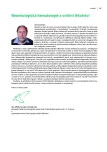-
Medical journals
- Career
Congenital and acquired bleeding disorders
Authors: Peter Salaj
Authors‘ workplace: Ústav hematologie a krevní transfuze, Praha
Published in: Vnitř Lék 2018; 64(5): 547-558
Category:
Overview
Hemostasis can be characterized as an array of physiological mechanisms providing both blood fluidity in the intact blood vessels and hemostasis in the event of impaired continuity of the blood vessel wall. The impaired hemostatic balance may lead on the one hand to an increased tendency to bleed, either spontaneously or only in response to an external stimulus. At the opposite end of bleeding are thrombophilic conditions characterized by an increased tendency to blood coagulation and thereby to the development of venous or arterial thrombosis. The hemostatic balance is the result of normal functioning of the blood vessel wall, platelets and plasma agents which include the coagulation and fibrinolytic systems and their inhibitors. By coagulation we understand the process leading to the formation of fibrin networks including the controlled interaction of coagulation factors. It is a physiological process as opposed to thrombosis which can be defined as increased coagulation under pathological conditions.
Key words:
coagulation – coagulation factors – coagulopathy – hemophilia – inhibitors of coagulation factors deficiencies – purpura – thrombocytopathy – thrombocytopenia
Sources
- Salaj P. Poruchy hemostázy. Maxdorf Jessenius: Praha 2017. ISBN 978–80–7345–513–2.
- Alving BM. How I treat heparin-Induced thrombocytopenia and thrombosis. Blood 2003; 101(1): 31–37. Dostupné z DOI: <http://dx.doi.org/10.1182/blood-2002–04–1089>.
- Cetkovský J. Intenzivní péče v hematologii. Galén: Praha 2004. ISBN 80–7262–255–2.
- Colman RW, Hirsh J, Marder VJ et al. Hemostasis and Thrombosis: Basic Principles and Clinical Practice. 4th ed. Lippincott Williams Wilkins: 2000. ISBN 978–0781714556.
- Mitchell Lewis S, Bain BJ, Bates I. Dacie and Lewis Practical Haematology. 10th ed. Churchill Livingstone Elsevier: 2006. ISBN 978–0443066603.
- Furlan M, Robles R, Solenthaler M et al. Acquired deficiency of von Willebrand factor-cleaving protease in a patient with thrombotic thrombocytopenic purpura. Blood 1998; 91(8): 2839–2846.
- George JN, Woolf SH, Raskob GE et al. Idiopathic Thrombocytopenic Purpura: A Practice Guideline Developed by Explicit Methods for The American Society of Hematology. Blood 1996; 88(1): 3–40.
- Sadler JE, Mannucci PM, Berntorp E et al. Impact, diagnosis and treatment of von Willebrand disease. Thromb Haemost 2000; 84(2): 160–174.
- Tsai HM, Lian EC. Antibodies to von Willebrand factor-cleaving protease in acute thrombotic thrombocytopenic purpura. N Engl J Med 1998; 339(22): 1585–1594.
- Silwer J. von Willebrand‘s disease in Sweden. Acta Paediatr Scand 1973; 238 (Suppl): 1–159.
- Lak M, Peyvandi F, Mannucci PM. Clinical manifestations and complications of childbirth and replacement therapy in 385 Iranian patients with type 3 von Willebrand disease. Br J Haematol 2000; 111(4): 1236–1239
Labels
Diabetology Endocrinology Haematology Internal medicine
Article was published inInternal Medicine

2018 Issue 5-
All articles in this issue
- Differential diagnosis of anemia
- Hemoglobinopathies
- Rare anemias from the group of congenital bone marrow failure syndromes
- Aplastic anemia
- Paroxysmal nocturnal hemoglobinuria
- Autoimmune hemolytic anemia
- Granulocytopenia
- Diagnosis and treatment of immune thrombocytopenia
- Hematopoietic stem cell transplantation for non-malignant hematological disorders
- Diagnostic strategies in disorders of hemostasis
- Congenital and acquired bleeding disorders
- Investigation of congenital thrombophilic conditions: when, in whom, focusing on what or not at all?
- Antithrombotics today
- Internal Medicine
- Journal archive
- Current issue
- Online only
- About the journal
Most read in this issue- Autoimmune hemolytic anemia
- Differential diagnosis of anemia
- Congenital and acquired bleeding disorders
- Hemoglobinopathies
Login#ADS_BOTTOM_SCRIPTS#Forgotten passwordEnter the email address that you registered with. We will send you instructions on how to set a new password.
- Career

